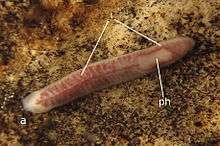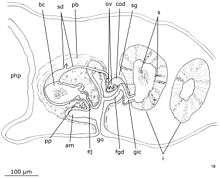Dimarcusidae
Dimarcusidae is a family of triclads found mostly in freshwater habitats of caves, although at least one species, Rhodax evelinae, occurs in surface waters. It is the only family within the suborder Cavernicola.[1][2] Currently the family contains only seven species distributed in five genera, although the total number of species is thought to be much higher.[3]
| Dimarcusidae | |
|---|---|
 | |
| Hausera hauseri | |
| Scientific classification | |
| Kingdom: | |
| Phylum: | |
| Class: | |
| Order: | |
| Suborder: | Cavernicola Sluys, 1990 |
| Family: | Dimarcusidae Mitchell & Kawakatsu, 1972 |
| Genera | |
|
See text | |
Description

The morphological features uniting species of Dimarcusidae are related to the reproductive system. Their ovaries are located more posteriorly than in most triclads, which usually have them close to the brain. The penis in species of Dimarcusidae contains glandular elements and the common ovovitelline duct is perpendicular to the female genital duct.[2]
Taxonomy
The family Dimarcusidae was erected in 1972 by Mitchell and Kawakatsu to include a new species, Dimarcus villalobosi. However, the same species had been briefly described by Benazzi in the same year as Opisthobursa mexicana and this name had priority, with Dimarcus villalobosi becoming a junior synonym. As a result, the family is called Dimarcusidae despite the absence of a valid genus Dimarcus.[1][2]
Phylogeny
Historically, species of Dimarcusidae have been classified as members of the suborders Maricola (marine triclads) or Paludicola (freshwater triclads). They received their own suborder, Cavernicola, in 1990, although their relationship to other triclads had not been settled.[2] Recent molecular studies, however, suggest that Cavernicola is the sister group of Maricola, thus being more closely related to marine than to freshwater triclads.[3]
Genera
Currently the family Dimarcusidae includes the following five genera:[4]
- Balliania Gourbault, 1978
- Hausera Leal-Zanchet & Souza, 2014
- Novomitchellia Özdikmen, 2010[5]
- Opisthobursa Benazzi, 1972
- Rhodax Marcus, 1946
References
- Mitchell, Robert W.; Kawakatsu, Masaharu (1972). "A new family, genus, and species of cave-adapted Planarian from Mexico (Turbellaria, Tricladida, Maricola)". Occasional Papers, Museum of Texas Tech University. 8: 1–16.
- Sluys, Ronald (1990). "A monograph of the Dimarcusidae (Platyhelminthes, Seriata, Tricladida)". Zoologica Scripta. 19 (1): 13–29. doi:10.1111/j.1463-6409.1990.tb00237.x. ISSN 0300-3256.
- Harrath, Abdel Halim; Mansour, Lamjed; Lagnika, Moïssou; Sluys, Ronald; Boutin, Claude; Alwasel, Saleh; Poch, Arnau; Riutort, Marta (2016). "A molecular analysis of the phylogenetic position of the suborder Cavernicola within the Tricladida (Platyhelminthes), with the description of a new species of stygobiont flatworm from Benin". Zoological Journal of the Linnean Society. 178 (3): 482–491. doi:10.1111/zoj.12430. ISSN 0024-4082.
- Leal-Zanchet, Ana; Souza, Stella; Ferreira, Rodrigo (2014). "A new genus and species for the first recorded cave-dwelling Cavernicola (Platyhelminthes) from South America". ZooKeys. 442: 1–15. doi:10.3897/zookeys.442.8199. ISSN 1313-2970. PMC 4205493.

- Özdikmen, H. (2010). "A new family and two genera names for Turbellaria (Platyhelminthes)" (PDF). Munis Entomology & Zoology. 5 (1): 115–117.